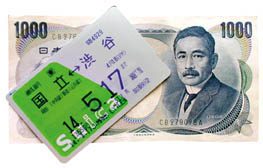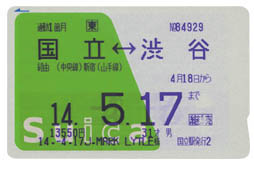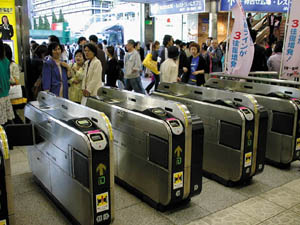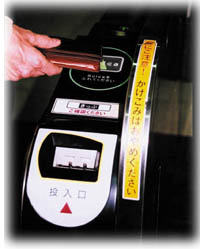From Ticket Reservations to Phones as Tickets and Money
Back to Contents of Issue: July 2002
|
|
|
|
by Jeffrey L. Funk |
|
 NTT DOCOMO'S ANNOUNCEMENT ON April 1, 2002, that it will use Bit Wallet's electronic money called Edy (short for euro, dollar and yen) in its phones is a major event in the mobile Internet landscape. Japanese consumers will be able to use their phones to make purchases under JPY3,000 simply by passing their phones over an integrated circuit (IC) card reader. This is expected to improve efficiency at checkout counters, provide more information to firms on consumer shopping patterns, and reduce the need to carry small change. NTT DOCOMO'S ANNOUNCEMENT ON April 1, 2002, that it will use Bit Wallet's electronic money called Edy (short for euro, dollar and yen) in its phones is a major event in the mobile Internet landscape. Japanese consumers will be able to use their phones to make purchases under JPY3,000 simply by passing their phones over an integrated circuit (IC) card reader. This is expected to improve efficiency at checkout counters, provide more information to firms on consumer shopping patterns, and reduce the need to carry small change.However, there are a number of significant questions. How many stores and vending machine manufacturers will implement the necessary readers that currently cost more than JPY20,000? How many will be willing to integrate the readers with their POS (point-of-sale) systems in order to utilize the information about consumer shopping patterns? What will the commissions be, how will they be divided up, and who will control the information? Will NTT DoCoMo's payment method extend to more expensive purchases and other applications like train, concert and movie tickets? Longer term, what are the implications for the world beyond Japan? This study looks at the use of phones as tickets and money in the Japanese market from a broad perspective. It looks at the simultaneous efforts to use smartcards as tickets and money and to put IC card functions (basically an integrated circuit) in phones. Improvements in IC technology have made it possible for card-sized devices to function as small computers. Currently, primitive forms of smartcards function as telephone cards and more sophisticated smartcards are used as train tickets and in GSM phones (called SIM cards) in many countries around the world. As firms improve the processing and short-distance communication capabilities in smartcards, new applications such as train, concert, movie and other tickets become possible. There are two concepts that play an important role in the evolution of Internet reservations -- smartcards and putting IC chips in phones. When the value of a product to one user depends on how many other users there are, the product is said to exhibit network effects or network externalities. Communication technologies such as telephones, email and the PC and mobile Internet are prime examples of products that exhibit network effects. The early success of entertainment contents in NTT DoCoMo's i-mode service in mid-1999 led to the emergence of positive feedback between these entertainment contents and young users. Subsequently, this positive feedback was extended to phones through the interaction between color displays and color contents. The concept of network effects plays an important role in the evolution of smartcards and putting IC functionality in phones. The more people who have and use smartcards (or phones with these capabilities), the more firms will want to accept them as tickets and money. Similarly, the more places where these cards can be used, the more people will be interested in acquiring and using them and phones that contain the IC card functions. Starting this positive feedback is important from a societal (economic growth) and a company standpoint, the latter from the standpoint of whose standard wins. This article will show that the initial high cost of cards and readers suggests that high-volume (both in frequency of use and money) applications will be the early drivers of the smartcards. Large firms like NTT DoCoMo, JR and convenience stores can use their volumes to force a standard on the market, while other railways, concert venues and movie theaters with smaller volumes will be slower to use smartcards. The second key concept is that of disruptive technologies. Disruptive technologies improve some aspects of product performance while sacrificing others, thus making the new technologies appropriate for a new set of customers. Because firms compete in different markets and for different customers, the same technology can be disruptive for some firms and not for other firms. The mobile Internet is disruptive for many firms that provide content for the PC Internet because it offers greater portability (more reach) but smaller screens (less richness) than the PC Internet. It is also disruptive for service providers and phone manufacturers who have traditionally focused on business users. This makes the mobile Internet more disruptive to Western than Japanese service providers since Western service providers (due to the importance of roaming) and manufacturers have historically focused on business users.  The concept of disruptive technologies also plays an important role in the evolution of smartcards. Credit card companies have long struggled to develop smartcards that would provide much higher security than current magnetic cards; the latter rely on time-consuming signatures and/or passwords to provide reasonable security. Although smartcards are not a disruptive technology when compared to magnetic cards, the non-contact based cards are a disruptive technology when compared to contact-based cards. Currently, contact-based smartcards like JCB's Monex have higher security and thus can be used in expensive purchases. Non-contact cards like the technology offered by Bit Wallet and adopted by NTT DoCoMo have higher processing times and lower costs but they have lower security and thus cannot be used in expensive purchases. However, as IC chip technology improves it is likely that non-contact smartcards will be able to provide the security necessary for more expensive purchases and more expensive tickets like airline tickets.
The concept of disruptive technologies also plays an important role in the evolution of smartcards. Credit card companies have long struggled to develop smartcards that would provide much higher security than current magnetic cards; the latter rely on time-consuming signatures and/or passwords to provide reasonable security. Although smartcards are not a disruptive technology when compared to magnetic cards, the non-contact based cards are a disruptive technology when compared to contact-based cards. Currently, contact-based smartcards like JCB's Monex have higher security and thus can be used in expensive purchases. Non-contact cards like the technology offered by Bit Wallet and adopted by NTT DoCoMo have higher processing times and lower costs but they have lower security and thus cannot be used in expensive purchases. However, as IC chip technology improves it is likely that non-contact smartcards will be able to provide the security necessary for more expensive purchases and more expensive tickets like airline tickets.If this happens, the sponsors of the winning non-contact smartcards could challenge the core business of credit card companies. The chances of this will increase if the sponsors of the non-contact smartcards are able to reduce commissions to a level lower than that offered by credit card companies, which are reportedly about 5 percent in Japan. Bit Wallet will initially charge much lower commissions than credit card companies do, since it is offering a prepaid system that has a lower cost of fraud than do expensive purchases with credit cards. Whether Bit Wallet or other promoters of non-contact cards can also offer low commissions in more expensive purchases is still unknown. Magnetic attraction Train tickets appear to represent the first major application for smartcards as tickets. In the transportation industry, smartcards are the latest method in an evolution that has passed through paper tickets to magnetic cards and now smartcards. Prepaid magnetic cards are currently widely used by train riders since they enable users to bypass time-consuming ticket machines and in many cases receive a discount. Discounts are particularly common with commuter passes where the first and last stations are designated on the pass. Prepaid cards are also beneficial to train companies since they reduce ticket dispensing machine costs including maintenance and money handling costs. All Japanese train companies widely use commuter passes. For example, the Japan Railways (JR) Group is the largest train company in Japan with more than 60 percent of the country's passenger miles and JR East has more than 50 percent of the passenger miles within JR. More than 70 percent of the passenger-miles in JR East are with commuter passes -- excluding shinkansen (bullet train) tickets. About 65 percent of the passenger miles in both Kintetsu and Meitetsu (regional train companies in the Osaka and Nagoya areas respectively) are with commuter passes. General-purpose prepaid magnetic cards are also used for non-commuter passes where the rider can travel most anywhere in a prescribed train network without purchasing a ticket. In addition to not having to purchase a ticket and thus wait in line, many train lines also offer discounts to encourage their use. JR East has found that about 5 percent of the card value is not used on average and since it does not provide a discount, it is making more revenues from prepaid cards than from tickets purchased from machines.  One problem with these general-purpose prepaid magnetic cards and commuter passes is that they typically cannot be used with different train lines. Although some train and bus companies jointly offer general-purpose prepaid magnetic cards, the number is small. For example, Kintetsu offers two different general-purpose magnetic passes -- one is compatible with JR and the other is compatible with the other train lines in the Kansai area. It had to introduce two different cards due to the large fare differences between JR Kansai and the other train lines. The ticket gates recognize the different cards and record the trips both internally and on the cards thus enabling the rail lines to divide up the revenues properly.
Although Kintetsu expects the number of general-purpose prepaid card users to grow, the problems of incompatible systems and a large number of small stations will limit their growth. Most train stations cannot handle magnetic cards since the stations are too small to justify the investment in the appropriate technology. This is why no train lines outside of JR and only a few in Tokyo and Kansai have introduced these general-purpose prepaid cards. If they do so, they must implement special measures in small stations, such as portable readers for disembarking passengers and other measures for
embarking passengers.
One problem with these general-purpose prepaid magnetic cards and commuter passes is that they typically cannot be used with different train lines. Although some train and bus companies jointly offer general-purpose prepaid magnetic cards, the number is small. For example, Kintetsu offers two different general-purpose magnetic passes -- one is compatible with JR and the other is compatible with the other train lines in the Kansai area. It had to introduce two different cards due to the large fare differences between JR Kansai and the other train lines. The ticket gates recognize the different cards and record the trips both internally and on the cards thus enabling the rail lines to divide up the revenues properly.
Although Kintetsu expects the number of general-purpose prepaid card users to grow, the problems of incompatible systems and a large number of small stations will limit their growth. Most train stations cannot handle magnetic cards since the stations are too small to justify the investment in the appropriate technology. This is why no train lines outside of JR and only a few in Tokyo and Kansai have introduced these general-purpose prepaid cards. If they do so, they must implement special measures in small stations, such as portable readers for disembarking passengers and other measures for
embarking passengers.Online ticketing Odakyu, a relatively small train company, was the first and perhaps still the only firm in the world to use phones as train tickets beginning in July 2001. Odakyu riders can make reservations and use their phones as tickets on two express trains in the morning (6:20 and 6:30) and many at night. Users must apply for membership by filling in a paper form and creating a prepaid account (typically JPY5,000). After they reserve a seat either on a PC or their mobile phone, they receive a ticket via electronic mail. This ticket is stored in the phone as a screen memo, a function that exists on all i-mode phones. The ticket price, which can run as high as JPY2,000, is automatically discounted from their account. Riders do need to purchase and use a non-reserved ticket to pass through the ticket wicket. But they are rarely asked to show their reserved tickets on the train, since conductors download data on ticket reservations to a PDA and check to see whether any occupied seat has not been reserved. It is only in this case or when riders cannot agree on the ownership of a seat that conductors ask riders to show their reserved ticket that is stored in the phone. Interest in Odakyu's service grew rapidly so that by mid-September 2001 there were 15,000 members and 10-20 percent of evening trains and 13 percent of morning trains were being reserved using mobile phones. It appears that only a few Japanese train lines will adopt Odakyu's approach due to differences in reserved ticket prices. Odakyu's approach is useful when the price of the reserved ticket is low and thus the chance of fraud and the desire to use credit cards is low. Of course, when the price of a reserved ticket is very low, it makes less sense to invest in and offer Internet reservation services. For example, Meitetsu does not plan to offer Internet reservation services due to the relatively low price (JPY350) of its train tickets. As the price of the ticket gets more expensive and demand increases for credit card services, higher security is needed. For example, Kintetsu began offering information on special express seats in December 2000 and began taking reservations on March 22, 2001, which was three days after it became an official i-mode site. Users must register for the service on a PC or mobile phone. These members can pay for their tickets online and receive them from a kiosk in the station by swiping their credit card. Inputting the credit card provides a form of user authorization and Kintetsu hopes this authorization will reduce the chance of fraud. The biggest application for reserved train seats in Japan is the shinkansen. JR Tokai manages the most highly trafficked segment of the bullet train system -- between Tokyo and Osaka -- where tickets cost about JPY25,000 for a roundtrip. It became possible to purchase and reserve bullet train seats via regular and mobile Internet in April 2001 and February 2002, respectively. Users must first register with JR's Internet service called Cyber Station by physical mail. Users pay for and pick up the tickets using the same type of system as offered by Kintetsu. Riders can also make reservation changes as much as they like, whereas previously they could only make one change.  The ability to make reservation changes on the Internet with a mobile phone is potentially a very convenient service. Anyone who has tried to make a bullet train reservation at a window in Tokyo Station on a Friday afternoon knows the length of time it takes to make or change a seat reservation. The ability to make mobile phone reservations will enable users to make these changes while they are on their way to the station and thus avoid the wait in line.
The ability to make reservation changes on the Internet with a mobile phone is potentially a very convenient service. Anyone who has tried to make a bullet train reservation at a window in Tokyo Station on a Friday afternoon knows the length of time it takes to make or change a seat reservation. The ability to make mobile phone reservations will enable users to make these changes while they are on their way to the station and thus avoid the wait in line.
Further, this service may also increase bullet train seat utilization since many people initially reserve seats and then end up riding in the non-reserved section of the bullet trains. This is because commuters often decide to take an earlier train than the one they booked a seat on; in this case, they just line up in front of one of the cars that contain non-reserved seats as opposed to waiting to change their reservation. These people are actually using two seats since JR does not know that the person has boarded another train and thus cannot give his or her reserved seat to someone else. Mobile phone reservation changes may decrease the numbers of these 'two seat users' and thus allow JR to save money by offering shinkansen with fewer carriages. While the number of registered members has grown dramatically, the number of riders who actually reserve bullet train tickets on the Internet is still apparently rather small. There are 100,000 members and the number has doubled since Internet reservations (they were possible previously by telephone) were announced in September 2001, but JR Tokai will not release the actual number of reservations being conducted on the Internet and admits that the high price of tickets is holding back growth. Currently, the Express card, which includes credit card capability, costs JPY1,050 a year and reservations on the Internet are not entitled to the discounts that are available elsewhere. JR Tokai expects growth to start when it revises bullet train prices this fall -- it plans to make it cheaper to buy tickets and reserve seats on the Internet than at a ticket window at the same time as it makes the Nozomi (the fastest trains) and other ticket (Hikari and Kodama) prices the same. It is possible that tickets purchased on the Internet will be as cheap as those purchased at discount shops. This will probably enable JR Tokai to take a larger percentage of ticket sales and sales from the discount shops will likely decline. Smart commuting JR East, the largest train company in Japan, introduced smartcards called Suica into its non-reserved seat lines on November 18, 2001. As of May 2002, there were already 3.6 million Suica users, of which 2.1 million are non-commuter pass users. As opposed to inserting a magnetic card into the ticket gate, riders place the card over a reader on the top of the ticket gates. The main advantage for users is that they can use the Suica card both as a commuter pass and also as a general-purpose prepaid card. They can also recharge the cards at train stations, as opposed to discarding them. The disadvantages of smartcards include difficulties with seeing the remaining balance on the card. They are also more expensive to manufacture than magnetic cards. People traditionally give the magnetic cards as presents -- also previously done with telephone cards until mobile phones made telephone cards largely unnecessary. The benefits to the train companies of using smartcards in their non-reserved seats include card distribution, maintenance and overall lower equipment and personnel costs. Distribution costs will drop, since the commuter and regular magnetic cards have been combined into one card. Also, since Suica is a non-contact technology, it requires less maintenance of the ticket gates than magnetic card readers, which require daily cleaning. One measure of success for Suica is the large number of users who are not commuter pass users. This suggests that Suica has convinced a large number of people to stop buying tickets with cash. Money handling and its related maintenance costs represent about 20 percent of a typical rail line's labor costs, which are typically about a quarter of their income. JR East is offering its technology for free to other train and bus lines; the Japanese National Rail Association has also adopted JR's technology as a national standard. If JR East can make its IC card the standard in the transportation industry, it hopes that firms from other industries will pay to use the technology (NTT DoCoMo's adoption of Edy reduces these chances, although it was to be expected, given that Bit Wallet is a joint venture between DoCoMo, Sony and Toyota). Although no other train lines have formally announced their adoption of Suica, privately it appears as though other JR lines and the Hankyu line will introduce Suica by 2004. Other train lines appear less interested in adopting Suica due to the large number of small stations in their train systems. But if a critical mass of train lines move quickly with the new technology, all of them (plus bus lines) may be forced to do so as riders expect a higher level of convenience. Smartcards will also make reserving seats on the shinkansen and similar trains easier since they will make it unnecessary to pick up a ticket. As described earlier, the one disadvantage of current Internet seat reservation services is that people still have to pick up the ticket from a kiosk or ticket window, which can be a problem when the train station is crowded. Smartcards will make it possible to provide better user authorization services, perhaps by third parties such as banks or credit card companies. This would increase user convenience and from the train operator's perspective, reduce the number of personnel needed in the train station. Of course, the higher price of bullet trains means that higher security is needed -- whether this is achieved through contact or improved non-contact cards is another issue. For non-reserved seats, smartcards enable dynamic pricing, thus potentially changing competition in the train market. Trains tend to be very crowded during rush hours and very underused at other times. Smartcards record the times in which people enter and leave the train system and thus they have the processing capability to record different fares based on these times. This would enable train companies to more easily discount their tickets during the slow times and perhaps move traffic to these off-peak times. The final benefit of smartcards may be the biggest. Such cards can be used to gather information on rider habits. One reason JR is offering its Suica technology to other train lines for free is to make it a national or even global standard, have it used in and around train stations as money and license it to other businesses such as convenience stores. While NTT DoCoMo's recent announcement concerning Edy may prevent Suica from becoming the standard in phones, Suica is compatible with Bit Wallet's card technology. Thus, it is expected that the same readers can be used with both technologies and thus Suica may be widely used in and around train stations for many years. Interestingly, the issue of train station size also influences the potential benefits from gathering information on rider habits. The larger the train station, the greater the number of stores and restaurants that might be interested in this information and in using the Suica card. Further, the all-encompassing nature of many of Japan's railroad companies means they tend to own a lot of businesses around the largest stations. Thus, we can expect railroads to implement smartcards first in these stations and their adjacent stores, both from a cost (economies of scale) and benefit standpoint. Next month in part two of this article, we'll examine how new payment technologies are likely to affect the shape of things to come; from how we use our mobile phones to getting a ticket to the movies. @ |
|
Note: The function "email this page" is currently not supported for this page.





